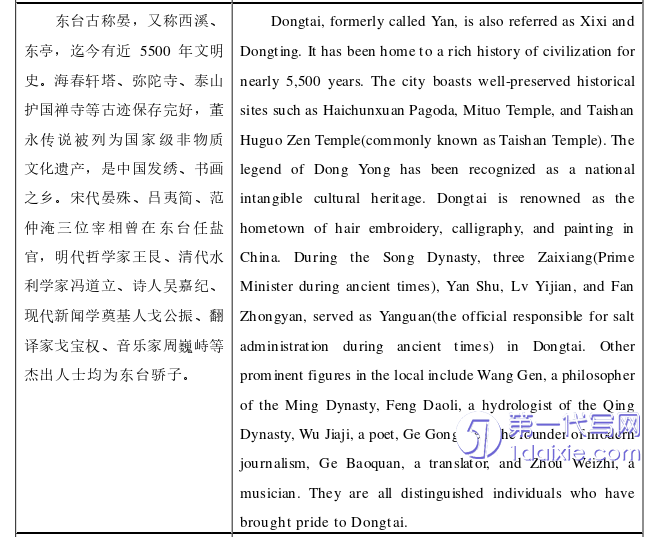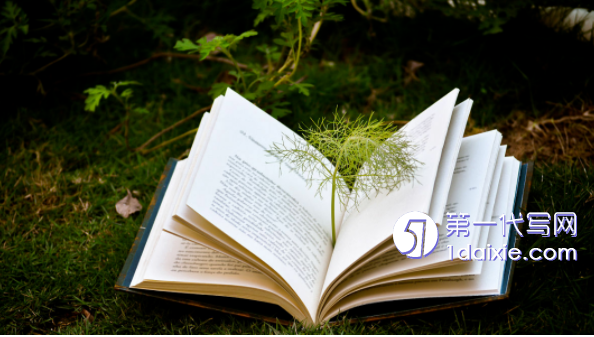本文是一篇英语论文,本报告是一篇基于外宣文本的汉英翻译实践报告,原文本主要来源于东台官方各类宣传平台。作为具有地域特色的外宣文本,原文本主要介绍东台的市情概况、政治、经济、历史、文化、景点、特产等方面内容。
Chapter One Task Description
1.1 Background of the Translation Task
Dongtai, renowned for its salt production, is a well-known “Land of Fish and Rice” in China, often hailed as the “Pearl of the Yellow Sea”. With a long history, abundant tourist resources, and a favorable geographic location, it holds the titles of a National Garden City, an excellent tourist city in China, and has been consistently ranked among the top 100 county-level cities in terms of comprehensive strength nationwide. Currently, an official English publicity material for Dongtai has not been released, leaving many foreigners unfamiliar with this city. With the desire to contribute to the promotion of the hometown, the translator has chosen the publicity materials of Dongtai City as the source text for this translation practice.
The source text is a compilation of publicity materials released by various official departments of Dongtai on major online platforms. It gives a comprehensive introduction to Dongtai, such as its geographical location, scenic spots, historical and cultural heritage, economic development, and so on. The entire text exceeds 10,000 words and encompasses aspects related to politics, economy, culture, resource, and more. Given that the source text is the integration of various publicity materials, the translator has made some adjustments to certain parts to enhance overall coherence. The translator hopes that this English translation of the publicity materials will attract foreign investment, promote local tourism culture, facilitate cultural exchanges, and, in turn, drive local economic development.

1.2 Translation Process
The translation process is a crucial aspect of translation activities (Cha and Tian, 2003:21-26), and providing an overview of this process is of utmost importance for the following reasons. Firstly, the translation process is essentially the iterative refinement of the translated text, an essential step in generating the optimal translation. Secondly, as translators continuously refine their work, they enhance their practical skills, contributing to their overall competence. The translation process primarily comprises three stages: the pre-translation preparation stage, the mid-translation stage, and the post-translation stage. The specifics are elaborated as follows:
1.2.1 Pre-translation
After determining the translation project, the translator’s first step is to select the translation materials. This involves consulting relevant official websites, understanding the context, gathering Dongtai’s publicity materials, and compiling them. Due to the complexity of the content, involving numerous local proprietary terms, the process can be divided into the following two main steps:
Chapter Two Source Text Analysis
2.1 Contents of the Source Text
The content of this translation project has been compiled by the translator based on publicity materials from various platforms in Dongtai City. The source text consists of four main sections: The first section provides a brief introduction to Dongtai from various perspectives, focusing on its diverse natural resources. The second section covers Dongtai’s economic development. The third section primarily discusses Dongtai’s urban development and administrative divisions. The fourth section highlights Dongtai’s scenic spots, historical and cultural heritage, as well as local specialties. This text systematically and comprehensively introduces readers to Dongtai’s geographical location, natural resources, historical and cultural aspects, and economic development. It aims to showcase Dongtai’s charm from multiple angles and convey the essence of “the Voice of Dongtai”.
2.2 Features of the Source Text
The source text is a promotional text, and the primary task of such texts is to enable the world to understand China. Therefore, the translation for external publicity needs to ensure its communicative function to the greatest extent possible. According to Huang Youyi (2004: 29-30), the best translation of external publicity is not a mechanical conversion of Chinese to another foreign language on a word-by-word basis, but rather a process that involves appropriate adaptation of the original Chinese text based on the thinking habits of foreign audiences. This adaptation may involve deletions, additions of contextual information, literal direct translation of certain parts, and at times, the use of indirect speech. Hence, the translator needs to analyze the textual features of the source text in order to ensure the quality of the final translation. The following is a detailed analysis:
2.2.1 Lexical Features
From a lexical perspective, the source text is replete with numerous proper nouns, primarily encompassing culture-loaded words and four-character structures. Culture-loaded words refer to the words that cannot be understood by the target readers without the necessary explanation due to the difference of the cultural background. For example, culture-loaded words like some official name including “宰相”, “巡宰”, “巡检” which were only used in the ancient China have the connotation of history and culture. Four-character structures such as “碧波荡漾”, “清澈见底” are common in the Chinese text which have always been used as modifiers.
Chapter Three Problems and Solutions ........................ 7
3.1 Translation of Culture-loaded Words .................................. 7
3.1.1 Transliteration with Annotation .................................... 7
3.1.2 Literal Translation with Annotation ......................... 10
Conclusion .......................... 23
Chapter Three Problems and Solutions
3.1 Translation of Culture-loaded Words
Culture-loaded words are commonly encountered in publicity materials, referring to “words, phrases, or expressions that encapsulate specific cultural information, often challenging to find equivalent terms in the target language” (Wu Wenyan, 2014:166-170). Therefore, to some degree, the translation quality of culture-loaded words significantly impacts the overall translation quality of publicity materials. In different cultural backgrounds, culture-loaded words have different meanings and may not have corresponding expressions respectively. To minimize barriers for foreign readers in accessing information and facilitating effective cultural communication, the methods of transliteration with annotations and literal translation with annotations will be applied in the translation of culture-loaded words.
3.1.1 Transliteration with Annotation
Transliteration is a commonly used translation method when dealing with cultural differences. It holds significant importance in preserving both the linguistic and cultural features of the source language (Chen Fangrong, 2011). Due to the unique nature of Chinese culture, many culture-loaded terms cannot be directly translated in the cultural context of English. Therefore, in addition to transliteration, translators also need to provide more detailed information in the annotations, while avoiding excessive alienation caused by the abuse of transliteration.

Conclusion
This chapter is a comprehensive summary by the translator of the current translation practice, which highlights the gains made by the author during the translation process. It includes reflections on crafting the translation practice report and provides guidance for the translator’s future translation endeavors. Through this translation practice, the translator has gained a deeper understanding of translating external propaganda texts. Such texts span various domains and require the translator to balance the source and target languages, employing suitable translation methods and techniques to achieve the best translation outcome. The main analysis in this report focuses on four translation challenges:
When dealing with the translation of culture-loaded words from the source text, the translator employs a translation skill that combines transliteration and annotation to handle such terms after thoroughly grasping the textual characteristics of the source text. This approach facilitates both cultural representation and enhances the target language readers’ comprehension of the cultural nuances in the source text. For similar contextual terms, a combination of literal translation and annotation is utilized to aid target language understanding.
reference(omitted)
